Page 293 of 436
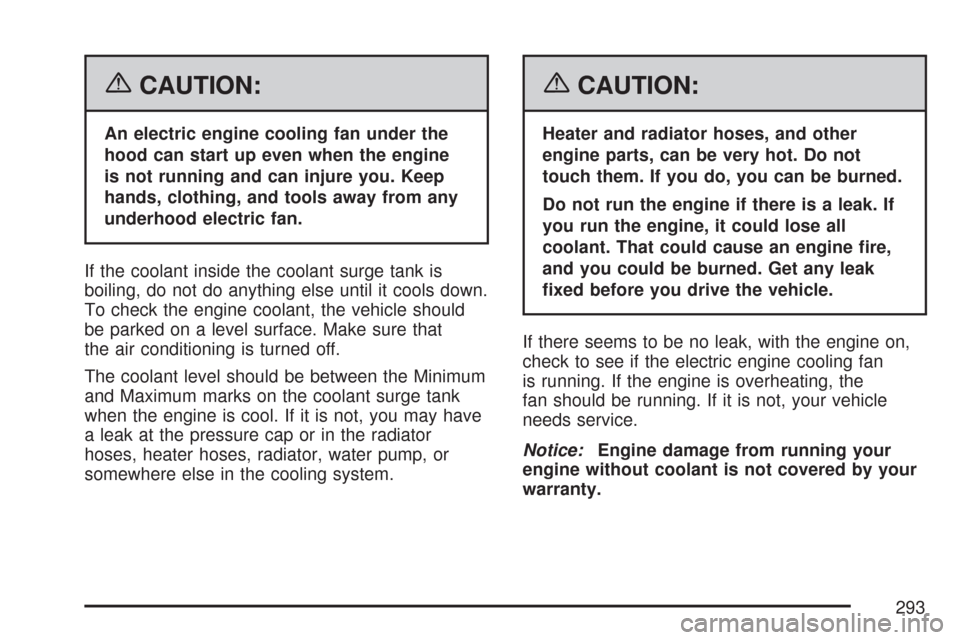
{CAUTION:
An electric engine cooling fan under the
hood can start up even when the engine
is not running and can injure you. Keep
hands, clothing, and tools away from any
underhood electric fan.
If the coolant inside the coolant surge tank is
boiling, do not do anything else until it cools down.
To check the engine coolant, the vehicle should
be parked on a level surface. Make sure that
the air conditioning is turned off.
The coolant level should be between the Minimum
and Maximum marks on the coolant surge tank
when the engine is cool. If it is not, you may have
a leak at the pressure cap or in the radiator
hoses, heater hoses, radiator, water pump, or
somewhere else in the cooling system.
{CAUTION:
Heater and radiator hoses, and other
engine parts, can be very hot. Do not
touch them. If you do, you can be burned.
Do not run the engine if there is a leak. If
you run the engine, it could lose all
coolant. That could cause an engine �re,
and you could be burned. Get any leak
�xed before you drive the vehicle.
If there seems to be no leak, with the engine on,
check to see if the electric engine cooling fan
is running. If the engine is overheating, the
fan should be running. If it is not, your vehicle
needs service.
Notice:Engine damage from running your
engine without coolant is not covered by your
warranty.
293
Page 295 of 436
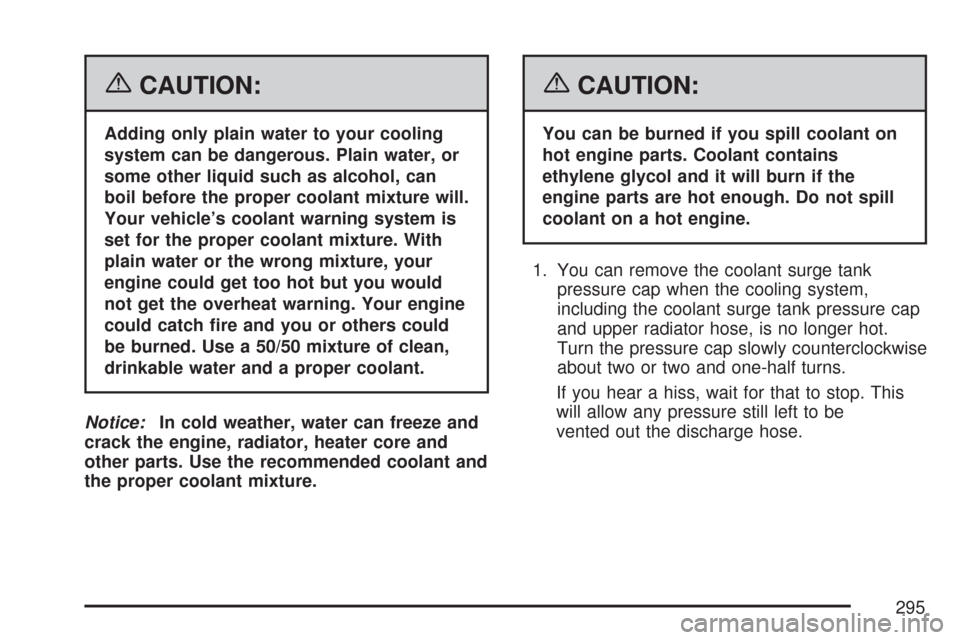
{CAUTION:
Adding only plain water to your cooling
system can be dangerous. Plain water, or
some other liquid such as alcohol, can
boil before the proper coolant mixture will.
Your vehicle’s coolant warning system is
set for the proper coolant mixture. With
plain water or the wrong mixture, your
engine could get too hot but you would
not get the overheat warning. Your engine
could catch �re and you or others could
be burned. Use a 50/50 mixture of clean,
drinkable water and a proper coolant.
Notice:In cold weather, water can freeze and
crack the engine, radiator, heater core and
other parts. Use the recommended coolant and
the proper coolant mixture.
{CAUTION:
You can be burned if you spill coolant on
hot engine parts. Coolant contains
ethylene glycol and it will burn if the
engine parts are hot enough. Do not spill
coolant on a hot engine.
1. You can remove the coolant surge tank
pressure cap when the cooling system,
including the coolant surge tank pressure cap
and upper radiator hose, is no longer hot.
Turn the pressure cap slowly counterclockwise
about two or two and one-half turns.
If you hear a hiss, wait for that to stop. This
will allow any pressure still left to be
vented out the discharge hose.
295
Page 301 of 436
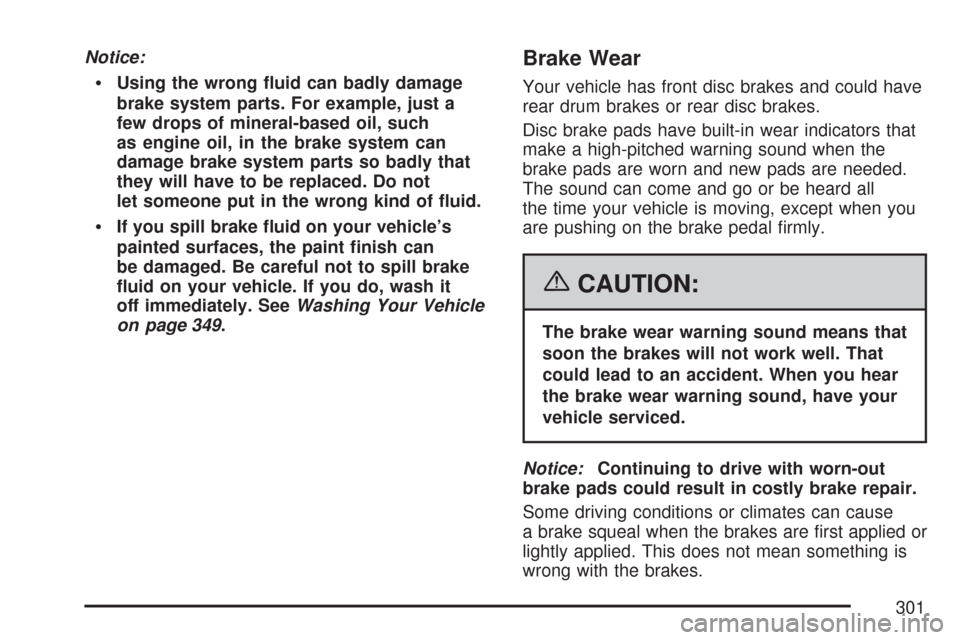
Notice:
Using the wrong �uid can badly damage
brake system parts. For example, just a
few drops of mineral-based oil, such
as engine oil, in the brake system can
damage brake system parts so badly that
they will have to be replaced. Do not
let someone put in the wrong kind of �uid.
If you spill brake �uid on your vehicle’s
painted surfaces, the paint �nish can
be damaged. Be careful not to spill brake
�uid on your vehicle. If you do, wash it
off immediately. SeeWashing Your Vehicle
on page 349.
Brake Wear
Your vehicle has front disc brakes and could have
rear drum brakes or rear disc brakes.
Disc brake pads have built-in wear indicators that
make a high-pitched warning sound when the
brake pads are worn and new pads are needed.
The sound can come and go or be heard all
the time your vehicle is moving, except when you
are pushing on the brake pedal firmly.
{CAUTION:
The brake wear warning sound means that
soon the brakes will not work well. That
could lead to an accident. When you hear
the brake wear warning sound, have your
vehicle serviced.
Notice:Continuing to drive with worn-out
brake pads could result in costly brake repair.
Some driving conditions or climates can cause
a brake squeal when the brakes are first applied or
lightly applied. This does not mean something is
wrong with the brakes.
301
Page 368 of 436
Capacities and Speci�cations
The following approximate capacities are given in English and metric conversions.
SeePart D: Recommended Fluids and Lubricants on page 396for more information.
ApplicationCapacities
English Metric
Air Conditioning Refrigerant R134aFor the air conditioning system refrigerant charge
amount, see the refrigerant caution label located
under the hood. See your dealer for more
information.
Cooling System 6.3 qt 6.0 L
Engine Oil with Filter 3.96 qt 3.75 L
Fuel Tank 11.9 gal 45.0 L
Transaxle, Automatic 6.2 qt 5.87 L
Transaxle, Manual 1.9 qt 1.8 L
Wheel Nut Torque 81 lb ft
110Y
All capacities are approximate. When adding, be sure to fill to the appropriate level, as recommended in this
manual. Recheck fluid level after filling.
Engine Speci�cations
Engine VIN Code Transaxle Spark Plug Gap
1.6L L4 (L91) 6Automatic and
Manual0.039-0.043 inch (1.0-1.1 mm)
368
Page 369 of 436
Normal Maintenance Replacement Parts
Replacement parts identified below by name, part number, or specification can be obtained from
your dealer.
Normal Maintenance Replacement Parts
Part GM Part NumberACDelco®Part
Number
Passenger Compartment Filter 96539649 —
Engine Air Cleaner/Filter 96536694 —
Engine Oil Filter 96458873/96395221 —
Fuel Filter 96537170 —
Spark Plugs 96130723 IFR6E11
1
Windshield Wiper Blade- Hatchback
Driver’s Side 96497155 —
Passenger’s Side 96619022 —
Rear 96301840 —
Windshield Wiper Blade- Sedan
Driver’s Side 96648556 —
Passenger’s Side 96648561 —
1NGK
369
Page 372 of 436
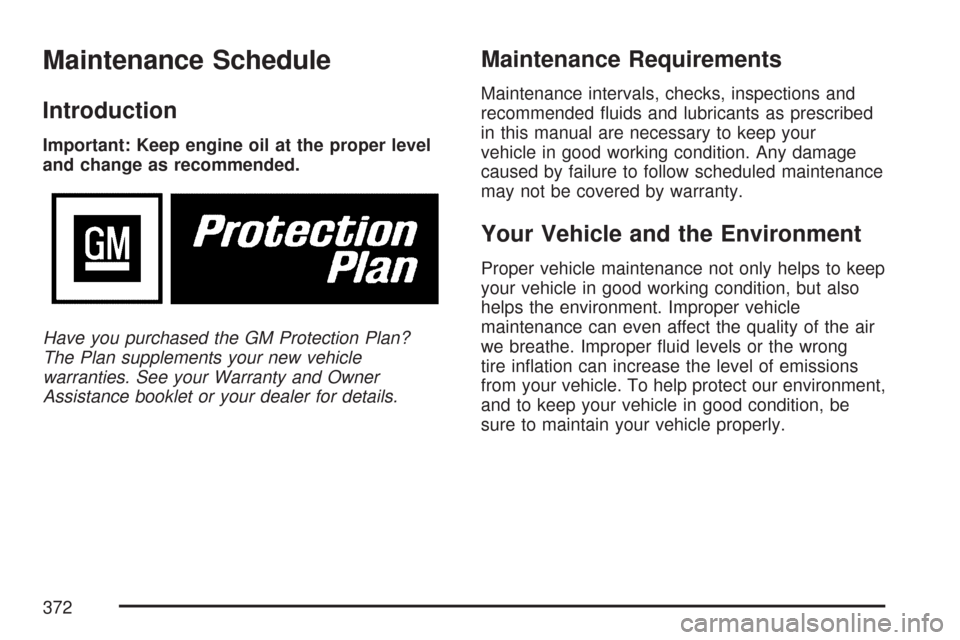
Maintenance Schedule
Introduction
Important: Keep engine oil at the proper level
and change as recommended.
Have you purchased the GM Protection Plan?
The Plan supplements your new vehicle
warranties. See your Warranty and Owner
Assistance booklet or your dealer for details.
Maintenance Requirements
Maintenance intervals, checks, inspections and
recommended fluids and lubricants as prescribed
in this manual are necessary to keep your
vehicle in good working condition. Any damage
caused by failure to follow scheduled maintenance
may not be covered by warranty.
Your Vehicle and the Environment
Proper vehicle maintenance not only helps to keep
your vehicle in good working condition, but also
helps the environment. Improper vehicle
maintenance can even affect the quality of the air
we breathe. Improper fluid levels or the wrong
tire inflation can increase the level of emissions
from your vehicle. To help protect our environment,
and to keep your vehicle in good condition, be
sure to maintain your vehicle properly.
372
Page 375 of 436
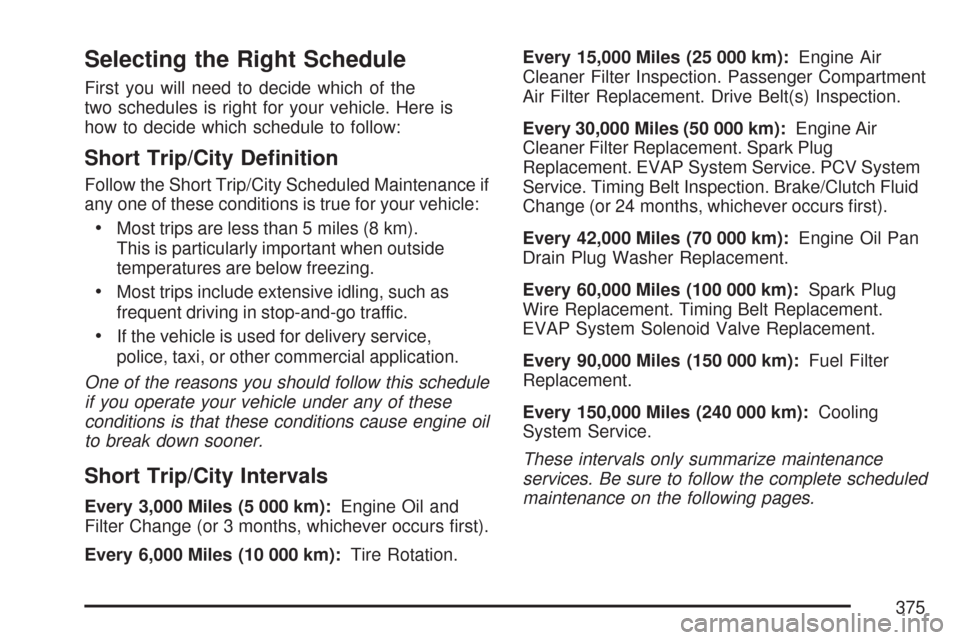
Selecting the Right Schedule
First you will need to decide which of the
two schedules is right for your vehicle. Here is
how to decide which schedule to follow:
Short Trip/City De�nition
Follow the Short Trip/City Scheduled Maintenance if
any one of these conditions is true for your vehicle:
•Most trips are less than 5 miles (8 km).
This is particularly important when outside
temperatures are below freezing.
•Most trips include extensive idling, such as
frequent driving in stop-and-go traffic.
•If the vehicle is used for delivery service,
police, taxi, or other commercial application.
One of the reasons you should follow this schedule
if you operate your vehicle under any of these
conditions is that these conditions cause engine oil
to break down sooner.
Short Trip/City Intervals
Every 3,000 Miles (5 000 km):Engine Oil and
Filter Change (or 3 months, whichever occurs first).
Every 6,000 Miles (10 000 km):Tire Rotation.Every 15,000 Miles (25 000 km):Engine Air
Cleaner Filter Inspection. Passenger Compartment
Air Filter Replacement. Drive Belt(s) Inspection.
Every 30,000 Miles (50 000 km):Engine Air
Cleaner Filter Replacement. Spark Plug
Replacement. EVAP System Service. PCV System
Service. Timing Belt Inspection. Brake/Clutch Fluid
Change (or 24 months, whichever occurs first).
Every 42,000 Miles (70 000 km):Engine Oil Pan
Drain Plug Washer Replacement.
Every 60,000 Miles (100 000 km):Spark Plug
Wire Replacement. Timing Belt Replacement.
EVAP System Solenoid Valve Replacement.
Every 90,000 Miles (150 000 km):Fuel Filter
Replacement.
Every 150,000 Miles (240 000 km):Cooling
System Service.
These intervals only summarize maintenance
services. Be sure to follow the complete scheduled
maintenance on the following pages.
375
Page 376 of 436
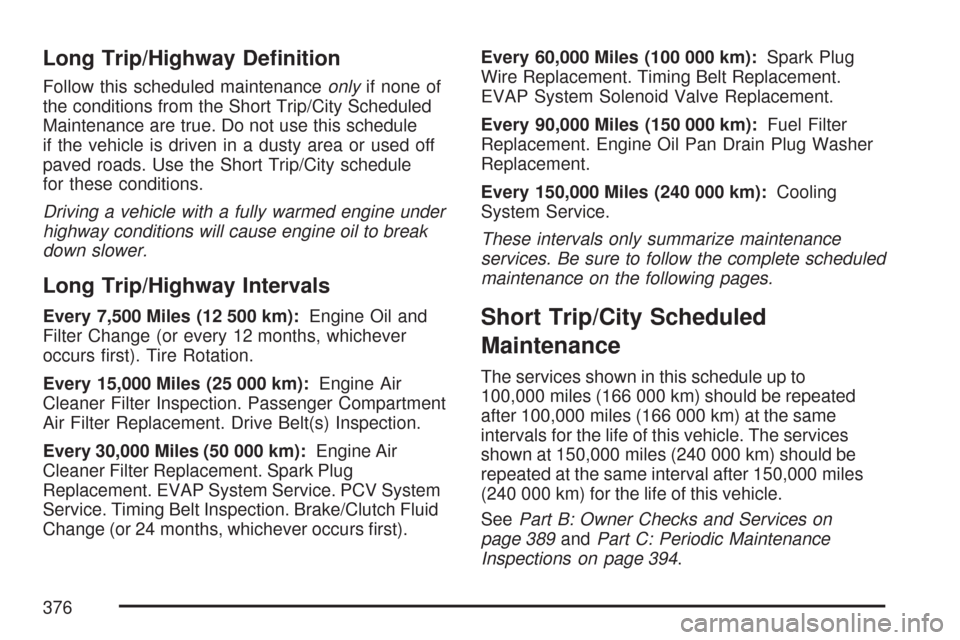
Long Trip/Highway De�nition
Follow this scheduled maintenanceonlyif none of
the conditions from the Short Trip/City Scheduled
Maintenance are true. Do not use this schedule
if the vehicle is driven in a dusty area or used off
paved roads. Use the Short Trip/City schedule
for these conditions.
Driving a vehicle with a fully warmed engine under
highway conditions will cause engine oil to break
down slower.
Long Trip/Highway Intervals
Every 7,500 Miles (12 500 km):Engine Oil and
Filter Change (or every 12 months, whichever
occurs first). Tire Rotation.
Every 15,000 Miles (25 000 km):Engine Air
Cleaner Filter Inspection. Passenger Compartment
Air Filter Replacement. Drive Belt(s) Inspection.
Every 30,000 Miles (50 000 km):Engine Air
Cleaner Filter Replacement. Spark Plug
Replacement. EVAP System Service. PCV System
Service. Timing Belt Inspection. Brake/Clutch Fluid
Change (or 24 months, whichever occurs first).Every 60,000 Miles (100 000 km):Spark Plug
Wire Replacement. Timing Belt Replacement.
EVAP System Solenoid Valve Replacement.
Every 90,000 Miles (150 000 km):Fuel Filter
Replacement. Engine Oil Pan Drain Plug Washer
Replacement.
Every 150,000 Miles (240 000 km):Cooling
System Service.
These intervals only summarize maintenance
services. Be sure to follow the complete scheduled
maintenance on the following pages.Short Trip/City Scheduled
Maintenance
The services shown in this schedule up to
100,000 miles (166 000 km) should be repeated
after 100,000 miles (166 000 km) at the same
intervals for the life of this vehicle. The services
shown at 150,000 miles (240 000 km) should be
repeated at the same interval after 150,000 miles
(240 000 km) for the life of this vehicle.
SeePart B: Owner Checks and Services on
page 389andPart C: Periodic Maintenance
Inspections on page 394.
376